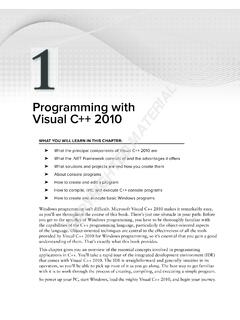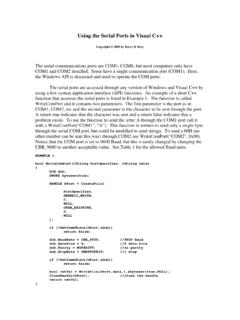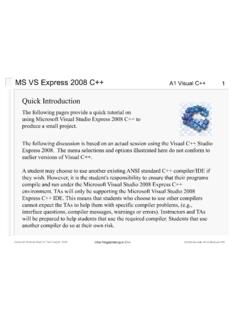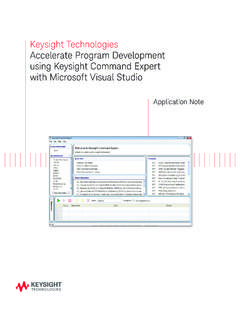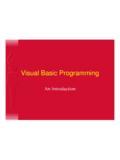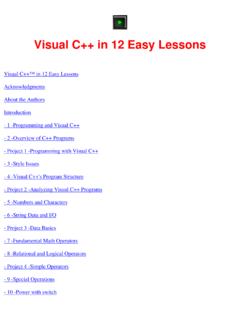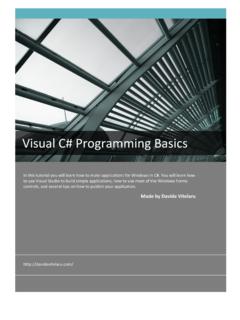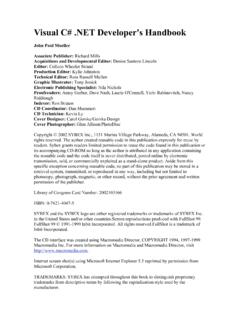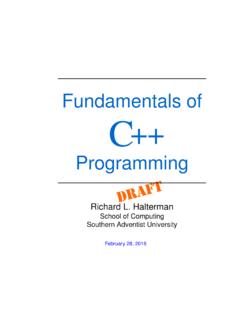Transcription of COSMETIC ACCEPTANCE CRITERIA - EPE Corporation
1 Document Number WI190-004 Revision A Page 1 of 18 FRM 120-007 Rev I/R Title: Department: Revision History Change Notice / Dev. Number Description Date Old Rev. New Rev. 100-229 Initial Release 1/16/09 - I/R 100-277 Revised Para 06/29/10 I/R A Reviewed and no changes required 06/02/11 - A Title Authorized Signatures Date Originator Robert Davies 1/16/09 Department Head Kirit Patel 06/29/10 Revised By George Sheldon 06/29/10 Documentation Coordinator George Sheldon/Kirit Patel 06/29/10 COSMETIC ACCEPTANCE CRITERIA QUALITY ASSURANCE Tier II Documentation Work Instructions EPE Work Instructions Title: Date Issued:06/29/10 Document Number WI190-004 Revision A Page 2 of 18 FRM 120-007 Rev I/R Purpose PURPOSE AND SCOPE The purpose of this document is to establish COSMETIC acceptability and non-acceptability CRITERIA for customer shippable parts, assemblies and final products that are purchased or consigned to EPE Corporation for value added assembly.
2 RESPONSIBILITIES Quality is responsible for maintaining this document and the content. Quality applies the information contained here in or as it is modified and agreed to between EPE and the customer to determine material compliance with this document. Program Manager is responsible for providing COSMETIC Specifications to EPE Customers prior to value added assembly. Purchasing/Buyer is responsible for communicating COSMETIC CRITERIA /requirements to all Suppliers of EPE Corporation . Manufacturing Operators are responsible for assessing questionable material conformance with this specification SURFACE COSMETICS General Inspection Requirements: COSMETIC inspection at EPE Corporation or its suppliers shall use the TIME and DISTANCE method of inspection as described in different sections of this document. The COSMETIC standards defined in this Workmanship Standard shall be used for training personnel, checking surface quality produced by any process and used in making Accept/Reject decision.
3 Viewing Conditions: All inspection will be made under normal artificial lighting, unaided and viewed in a manner that duplicates the typical end use of the product. During COSMETIC inspection, only visual qualities (appearance) of the part surface shall be considered. Surfaces shall be viewed without the aid of magnification, at an angle approx. 45 to normal of the surface to be inspected. EPE Work Instructions Title: Date Issued:06/29/10 Document Number WI190-004 Revision A Page 3 of 18 FRM 120-007 Rev I/R The following are Inspection CRITERIA : Inspection shall be conducted using the unaided eye. Viewing distance shall be 18 or 24 as specified by surface class. Viewing angle shall be 45 to the surface. Light source shall be by cool white fluorescent light; the light source shall be positioned and distanced to provide optimal viewing and minimized glare and shadowing of the sample. In the case where black light or other special lighting is required to detect or accent defects, the specifics specified in this procedure shall prevail, except where exempted in writing by the customer Where subjectiveness intervenes in the assessment form/fit/function shall take precedent or where available 3rd party decision (including) but not limited to the customer/end user shall prevail.
4 General Guidelines Viewing duration shall be based on part size as well as complexity. Codes Class A Class B Class C Viewing Distance 450mm (18 in.) 450mm (18 in.) 600mm (24 in.) Viewing Time 10 seconds 5 seconds 3 seconds Viewing Area Discernable variation from the guidelines specified within this document shall be grounds for rejection. Class A surfaces shall be manipulated during inspection to achieve maximum reflection of a light source. Class B and Class C surfaces shall NOT be manipulated during inspection. Refer to Class A, Class B, and Class C viewing condition figures below. EPE Work Instructions Title: Date Issued:06/29/10 Document Number WI190-004 Revision A Page 4 of 18 FRM 120-007 Rev I/R Class A (Viewing Conditions cool white light): Class B (Viewing Conditions cool white light): EPE Work Instructions Title: Date Issued:06/29/10 Document Number WI190-004 Revision A Page 5 of 18 FRM 120-007 Rev I/R Class C (Viewing Conditions cool white light): EPE Work Instructions Title: Date Issued:06/29/10 Document Number WI190-004 Revision A Page 6 of 18 FRM 120-007 Rev I/R SURFACE CLASSES The following assumes the item being viewed is an assembled unit as it would appear in an operational environment.
5 Assemblies utilizing unlike materials on the same viewing surface ( plastic handles and fasteners on a sheet-metal panel) will have the same COSMETIC class standard applied from the applicable material tables. When viewing separate components it must be understood which surfaces correspond to the classification below. CLASS A - Highly decorative surface in constant view of the customer. CLASS B Moderately decorative surface in occasional view of the customer without the unit being removed. Examples include but are not limited to the top and sides of rack-mounted chassis, rear faceplates. CLASS C Non decorative surface not readily visible to the customer except when the unit is moved. PLASTIC PARTS Acceptable CRITERIA : Acceptable Class A, Class B or Class C defects should not affect FIT or FUNCTION. In such cases affecting fit or function, the parts are automatic rejects. For General inspection requirements and viewing conditions reference beginning with Section (Various materials- Surface Cosmetics) This spec.
6 Applies to parts with inserts and parts resulting from post molding operations. 50 sq. inch area in the Tolerance Table is the limit for the number of defects found acceptable within the surface area. For larger surfaces the number of defects allowed increases proportionally. Clustering of more than two defects is not acceptable. EPE Work Instructions Title: Date Issued:06/29/10 Document Number WI190-004 Revision A Page 7 of 18 FRM 120-007 Rev I/R Texture: Molded texture specs are the default plastic textures adopted by EPE Corporation . Defect Definitions: Protrusion A raised area on a surface (blister, bump, ridge or gate mark) Discoloration Change from original color or inconsistent color within the same part Burns Black specs in the surface of the part due to overheating Splays Marks from gases or voids in the surface of a part. Flow Marks Wavy or streaked appearance of a surface.
7 Haze Cloudiness on an otherwise transparent part. Pits Small craters on a surface. Specks Small pieces of material stuck to the surface. Scratches Shallow grooves forming lines on the surface. Phantom Scratches Light surface marring, visible through manipulation, but not from all angles or sides. Sink Depression on the surface. Knit/Weld Line A visible line formed at the intersection of material flow. Blush Inconsistency in surface gloss. Parting Line/Flash A visible line and or raised surface on the part formed at the intersection of (2) mating surfaces of the mold. Texture Variation Visible variation of texture from within the same part. Mold Release Spray lubricant used for ease of part release from the mold. Color Variations Color of part appears different from color sample chips. Tolerance Table: (Plastic parts Surface Cosmetics) The total number of defects per surface shall not exceed the acceptable limit.
8 Use the Table below for training inspection personnel and making Accept/Reject decisions. EPE Work Instructions Title: Date Issued:06/29/10 Document Number WI190-004 Revision A Page 8 of 18 FRM 120-007 Rev I/R SHEETMETAL PARTS Acceptable CRITERIA : Acceptable Class A, Class B or Class C defects should not affect FIT or FUNCTION. Any COSMETIC defects that negatively affect fit or function of the part or assembly shall be rejected. For general inspection requirements and viewing conditions reference Section 6 (Surface Cosmetics). This spec applies to both Pre-Plated and Post Plated parts. 50 Sq. inch area in the Tolerance Table is the limit for the number of defects found acceptable proportionally. Clustering of more than two defects is not acceptable. Defect Type Class A Class B Class C Protrusions Not Acceptable Qty 2 (Max) per 50 Sq. Area. Max Dim: .010 Sq A x .015 H Qty 8 (Max) per 50 sq.
9 Area. Max Dim: .020 Sq. A x .030 H Discoloration, Flow marks, Haze, Burns and Splay Not Acceptable Qty 4 (Max) per 50 Sq. Area. Max Dim: .010 Sq. Area. Acceptable Pits and Specks Not Acceptable Qty 4 (Max) per 50 Sq. Area. Max Dim: Dia. x Dp (Pits) Max Dim: Dia. X .015 H (Specks) Acceptable Scratches Not Acceptable Qty 4 (Max) per 50 Sq. Area Max Dim: L x .020 W Acceptable Phantom Scratches Not Acceptable Qty 4 (Max) per 50 Sq. Area Max Dim: L x .020 W Acceptable Sink Marks Not Acceptable Qty 2 (Max) per 50 Sq. Area Max Depth: Acceptable Knit/Weld Lines Not Acceptable Qty 2 (Max). Max Dim: Wide Acceptable Blush Not Acceptable Acceptable Acceptable Parting Lines/ Flash Not Acceptable Flash: Max Dim: .005 protrusion from base surface. Mismatch/Step: Max Dim: .005 . Diff from one surface level to another .010 Max Texture variation: Visible variation on the surface Not Acceptable Acceptable Acceptable Mold release on surface Not Acceptable Not Acceptable Not Acceptable Color Variation Not Acceptable Not Acceptable Acceptable EPE Work Instructions Title: Date Issued:06/29/10 Document Number WI190-004 Revision A Page 9 of 18 FRM 120-007 Rev I/R Fingerprints: No fingerprints, whether they penetrate the plating or not, are allowed in Class A, B or C.
10 (Wear appropriate protective garments) Defect Definitions: Rainbow effect Zinc plating may have discoloration or the rainbow effect. Rust/ Oxidation Chemical reaction of exposed metal with oxygen (air). Discoloration Any change from original color, intended color or inconsistent color. Scratches Visible but cannot be felt with thumbnail. Please consult your Quality Engineer or Process Engineer if you have product specific questions regarding Acceptablility. Gouge Surface imperfection, deeper than a scratch, penetrates into plating, often with raised edges. Plating Marks and Runs Visible inconsistencies in the surface due to the plating process. Such as bleed outs, water runs and hook marks. Any mark, pit, scratch or gouge, should not penetrate the plating. Marks Pits, sanding or other marks on base material that remain visible after coating. Non-uniform gloss Areas that have insufficient or excessive gloss. Grease or Oil Used in the process and left on the surface (not cleaned).

